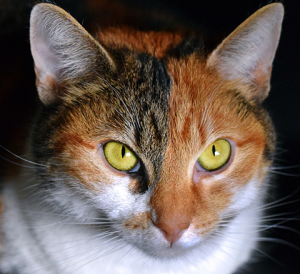FLUTD, or Feline Lower Urinary Tract Disorder, is the commonest cause of cystitis (bladder inflammation) in cats. Unlike in dogs, bacterial infections are uncommon in cats (and almost unknown in cats under eight years old). In most cases, cystitis in cats is a result of an abnormal response by the cat’s body to some external problem. 
What is the cause?
FLUTD is caused primarily by stress. Cats who become stressed start to suffer from progressive damage to their bladder lining, which eventually leads to cystitis.
Cats have evolved to be small predators, in the middle of the food chain; as a result they are very sensitive to stressful situations. So, any change in the environment is inherently stressful – whether that is a change in the furniture, or a new carpet, or an extension, it doesn’t matter. The presence of other large animals (who might conceivably be a threat) is also stressful. While cats can, and do, get used to and become friends with individual humans (or even dogs), the presence of strange humans or canines is always stressful.
In addition, these ancient wild cats were solitary hunters, who never came together except to breed. Now, modern cats are more tolerant than their ancestors, but they are still sensitive to the effects of crowding. So, the presence of strange cats, or even stress from too many cats sharing limited resources, can also be a problem.
Which cats are at risk?
Any cat who is stressed! However, there are other risk factors – such as reduced drinking and obesity. In addition, tomcats (especially neutered toms) are at increased risk of a urinary obstruction (blocked bladder).
So, what are the symptoms?
Most commonly, cats seem uncomfortable while using the litter tray, and may pass blood-stained urine. Usually, they will pass small amounts of urine, more frequently than usual. They also may start urinating in places other than their litter tray.
Although uncomfortable, and definitely requiring treatment, in most cases FLUTD is not life-threatening. However, occasionally the urethra (the tube leading from the bladder to the outside world) becomes blocked with debris and blood. This is most common in tomcats (who have a smaller urethra), and if untreated is fatal within a couple of days.
How can it be treated?
In most cases, pain relief and relieving the underlying stress are sufficient. There are two phases to stress relief in cats:
- Remove the cause: if possible, identify and remove the underlying problem. No more stressor, no more stress, no more FLUTD – simple! As the most common stressor is overcrowding (from the cat’s perspective!), making sure there are enough food and water bowls and litter trays for every cat, plus one spare, is a good start.
- Of course, you can’t always do that (knocking down a new kitchen because the cat doesn’t like it isn’t usually practical, for example). In that case, you have to help them manage the stress. There are a number of options:
- Feliway – this is a pheromone-based product which reassures cats that they are safe. It’s very effective against all types of stress!
- Prescription medications that relieve stress may be needed in some cases – our vets will be able to prescribe them, if needed.
In cats who are prone to FLUTD for any reason, glycosaminoglycan supplements may also be useful. These help to reinforce the bladder lining, preventing the stress-induced deterioration.
If the bladder becomes blocked, this is a medical emergency – we will need to anaesthetise them, and pass a catheter to flush out the debris and allow them to urinate. Without treatment, cats with a complete obstruction will die.
If you think your cat may have cystitis, make sure that you get them checked out by one of our vets as soon as possible!
